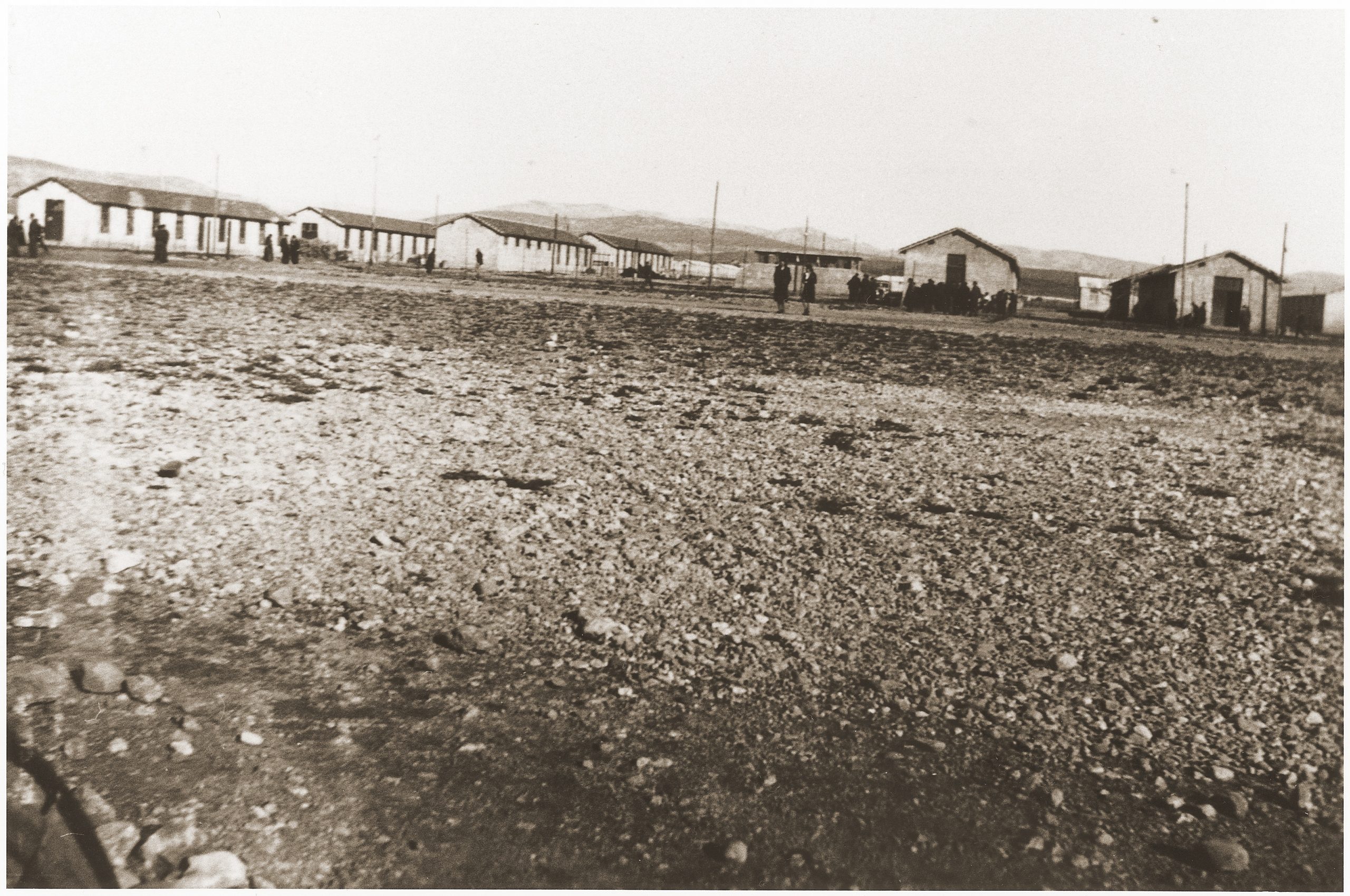Opened on 14 January 1941, the Rivesaltes camp, located in the Pyrenees in southern France, was the most important detention camp for ‘Nomades’ in this region until its dissolution on 22 November 1942.
Network of Internment Camps in the Pyrénées-Orientales
In the Pyrénées-Orientales, the network of internment camps used by the Vichy regime against ‘Nomades’ finds its roots in the political response of the Third Republic to the aftermath of the Spanish Civil War. Overwhelmed by the arrival of masses of republican refugees and defeated soldiers, the French authorities hastily set up makeshift internment camps along the Roussillon coast: Argelès, Saint-Cyprien, Le Barcarès and Agde were created for this purpose in February 1939. After the French defeat in 1940, the Vichy regime decided to use these camps to intern ‘undesirable’ individuals such as Jews from Germany and Central Europe and other categories of refugees. On 28 September 1940, a circular from the Ministry of Interior on the treatment of populations expelled from Alsace and Moselle by the Germans during the summer 1940 ordered that the ‘Nomades’ from Alsace and Moselle had to be sent to the Argelès camp.
Argelès and Agde
From October 1940 onwards, Argelès and Agde were the two main internment camps for Sinti, Roma and Yenish people, but the archives documenting their presence remain very fragmentary. At the beginning of November 1940, a report from the International Red Cross stated that 382 ‘Nomades’ from Alsace and Moselle were interned in Argelès, in a specific area of the camp where the living conditions were particularly disastrous and led to several outbreaks of diphtheria and measles. The death rate was high and mainly affected children; between October 1940 and July 1941, 23 deaths were registered in the camp hospital. Moreover, in October 1940, a severe flood resulted in significant material damage to parts of the camp. The authorities also used Argelès to intern ‘itinerant’ families with connections to Spain and ‘Nomades’ who were transferred there by the prefects of other departments in the unoccupied zone after periods of forced residence.
During the same period, the Agde camp was also used to collect ‘Nomades’ expelled from Alsace and Moselle; on 28 November 1940, 231 ‘Nomades’ from this area were recorded in the camp. Among them were Charles Meckes (1911–unknown), Geneviève Meyer (1914–unknown) and their two children, Charles (1934–unknown) and Xavier (1935–unknown), a Yenish basket-maker family who lived in a trailer in the suburbs of Haguenau before the war. With the opening of the Rivesaltes camp in January 1941, the internees from Agde and Argelès were progressively transferred there; on 15 January 1941, the entry register of the Rivesaltes camp recorded 93 ‘Nomades’ from Agde and on 20 June 1941, 448 internees from Argelès.
Rivesaltes Camp
The Rivesaltes camp, also known as ‘Camp Joffre’ after Joseph Joffre (1852–1931), a victorious French general of the First World War, was designed by the War Ministry in 1935, initially for military purposes. Throughout its construction, the French authorities faced logistical difficulties because of the violent weather peculiar to the Pyrénées-Orientales region. Located near the city of Perpignan, covering six square kilometres and comprising 150 barracks, built on a vast plain of scrubland and beaten by strong winds, this facility became an internment camp for civilian populations under the Vichy regime. In less than two years, a total of 17 500 people were interned at Rivesaltes; more than 9 000 Spaniards, 7 000 Jews and nearly 1 400 ‘Nomades’ passed through this camp between January 1941 and November 1942. ‘Nomades’ were mainly gathered in block (îlot) K until August 1942, when it was used for the internment of Jewish families arrested in the south of France during the mass roundups of the summer of 1942.
Rivesaltes was never the only active camp in the area where ‘Nomades’ were interned; transfers of internees between Rivesaltes, Argelès, le Barcarès and Gurs remained frequent and caused the separation of many families. Survivors’ testimonies mention the precarious living conditions inside the camp and the numerous attempts of the interned families to escape and join their relatives hiding in cities like Lyon, or to return to Alsace by crossing the demarcation line. More than half of the internees at Rivesaltes tried to escape at least once. This was the case of Antoine Weiss (1897–unknown) and his family, who were re-arrested near Dijon and interned in the Arc-et-Senans camp on 10 September 1941.
In total, the deaths of 34 ‘Nomades’ were recorded in Rivesaltes, mainly children and elderly people. In the face of these living conditions, several aid organisation workers intervened in the camp to help the internees. Friedel Bohny-Reiter (1912–2001), from the Swiss Children’s Aid, documented her activity in a published diary and in numerous photographs of ‘Nomades’ from Alsace taken inside the camp. From the summer of 1942, Rivesaltes was also the main transit site where the Vichy regime gathered Jewish families rounded up in the unoccupied zone; for most of them the next stops were Drancy and Auschwitz.

View of the Rivesaltes camp, France, 1941/42. Rivesaltes, located in the Pyrenees in southern France, was the largest detention camp in this region for members of the Sinti and Roma communities, who were labelled ‘nomades’ by the authorities. In less than two years, a total of 17 500 people were interned at Rivesaltes; more than 9 000 Spaniards, 7 000 Jews and nearly 1 400 ‘nomads’ passed through this camp between January 1941 and November 1942.
The photograph was taken by Friedel Bohny-Reiter (1912–2001), who was a member of the Swiss Children’s Relief Organisation and provided humanitarian aid in the camp. She documented her work in a diary that was later published and also took numerous photographs of Sinti:ze and Roma in the camp.
Photographer: Friedel Bohny-Reiter
On 25 March 1942, a meeting took place in Vichy to settle ‘the Nomad question’ in the unoccupied zone. Following this conference, the Vichy authorities decided to build a new internment camp in the Camargue region and transfer the ‘Nomades’ from Rivesaltes. In November 1942, after the German and Italian invasion of the unoccupied zone, the camp was requisitioned for use by German military, and on 22 November, the 299 ‘Nomades’ still present in Rivesaltes were transferred to the Saliers internment camp, on the outskirts of Arles in the Bouches-du-Rhône.
Aftermath
After the war, the Rivesaltes camp continued to be used by the French authorities to intern civilians; these included so-called ‘harki’ families—Algerian Arabs who had served in the French army during the Algerian War (1954–1962) and fled Algeria in 1962.
The camp’s history under the Vichy regime was gradually forgotten up until the 1990s, when a local newspaper reported the discovery of archival materials from the camp administration dealing with the deportation of the Jewish families. Still used as an administrative detention facility for illegal immigrants until 2007, the former site of the Rivesaltes camp increasingly attracted the interest of political leaders, memorial associations, and deported survivors.
In 1994, a first stele was erected on the initiative of Serge Klarsfeld (born 1935) in memory of the Jews deported from the Rivesaltes camp to Auschwitz. Because of its specific history, the Rivesaltes camp is a point where a number of collective memories converge, and various commemorative initiatives succeeded one another, including a 1999 project for a monument to the memory of the Spanish Republicans and one for a memorial to the Harkis in 2019. In 2009, a monument was built to mark the internment of the ‘Nomades’.
In 2015, the Memorial of the Rivesaltes Camp was inaugurated and dedicated to the preservation and dissemination of these multiple collective memories.
For future research on the history of ‘Nomades’ internees, a decisive milestone was reached in 2020 when the departmental archives of the Pyrénées-Orientales published an online database listing the 94 000 internees who passed through the camps of Rivesaltes and Argelès during World War II.




